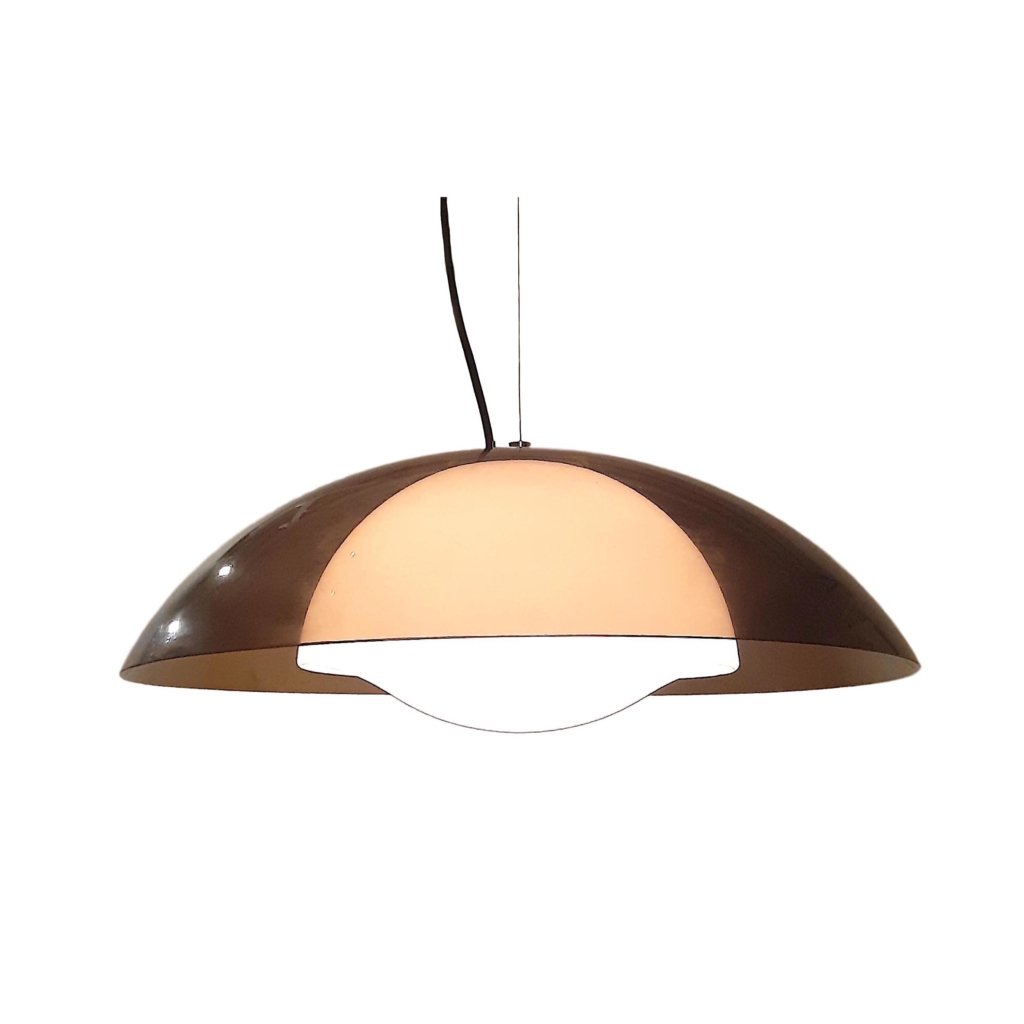Pt. 3...
So his well known buildings exhibit a lack of unity that keeps them from being great works.
And his lesser known buildings exhibit, in my humble opinion, some of the best of what modern architecture should have become, though they too lack the virtuosity of a great artist. His lesser known buildings would have made me hire him to build a stellar tract sub division that the elitist in him might have prevented him from doing. And it would have been an absolutely great tract subdivision that would have shown the way for all others to follow. Or I would have loved to hire him for a shopping mall...not a major shopping mall where Johnson would have felt he had to do down the road graphics to advance his rep, but a 150,000 sf community shopping center in suburban Connecticut, where he did not feel he had to put on the dog. His virtues as a technician proficient in modernist form language could have advanced the moribund-from-birth form language of community centers.
Johnson appears to have understood the kind of architect he truly was far better than those who have evaluated him, so far. He revealed himself, when interviewed about Louis Kahn. Kahn he said was a great artist and he was, he implied, by comparison, an exceptional technician and deep thinker with sufficiently good taste to recognize the profound virtuosity of Louis Kahn. I couldn't agree more.
In the end, for me anyway, Johnson's greatest contribution to architecture will not be his best-known buildings (they will soon haunt him I believe), or his ability to distinguish the likes of Kahn (having not only a good shit-detector, but a good brilliance-detector is a gift in its own right), or the wonderful lesser known buildings that he designed (something that in time will keep him an important figure in modernist history for those who actually care about how to practice modernist architecture).
His greatest contribution will be his theory, or perhaps heuristic, regarding the importance of the processional in architecture. All architects, builders and developers can agree that buildings have space programs that either work well or poorly. Every major architect I have ever studied has spent significant verbiage expounding on space programming. But until Johnson, I believe most description and evaluation distilled either to unpersuasive gropings for understanding in the dark, self promoting hustling dressed up as faux profundities, or quasi spiritual jibberish.
Space programming is incredibly hard and elusive to think analytically about for all but a few persons.
Pt. 4...
And for the few who can think about it analytically, it is extremely difficult to avoid descending rapidly in technological didactics. By this I mean lectures on how space programming can be reduced entirely to lifeless, utterly rational maps of circulation. In a mall, we force the foot traffic to have to walk between the two anchors for necessities and then crowd high margin, non essential purchasing opps. up against both sides of them as they walk. Throw in a few hard benches, so they can survive the walk, but not stop for long. And then the next generation of malls says well, lets create some oasis's along the way where we can drag some more discretionary income from them. And so on. It is all an extractive, rational model of fungible humans manipulated by stimulation inputs to relieve nervous needs, while acquiring basic needs.
Houses aren't much different. There the calculus distills to looks and steps. Is the look heavy enough and sumptuous enough to make the feel secure, whether the space is open or closed and are the cabinets handy.
Don't get me wrong. I love sweet reason. Rational layouts make the beautiful even more beautiful.
But space programming has so far largely eluded formulizing (or "heuristicizing") in a way that I sense human beings fundamentally interact with space.
Human beings try to modulate their interaction with space. They try to interact with space progressively in aspects of scale, openess, light, color, and so on. This was something Frank Lloyd Wright understood intuitively and then botched explaining in all his jibberish about radial, hexagonal, open floor plans centered on this, or that feature, or what ever jibberish he happened to come up with at various times to rationalize after the fact what he seemed often to do by instinct. Frank Lloyd Wright gently holds your hand and eye and progresses you into through and out of every truly good building of his I have had the privilege to experience. People like Wright buildings, because whether they leak or not, they are, dare I say it, very caring and gentle on the sensibilities of the person walking into, through, and out of. You feel nurtured and cared for in his architecture even as it introduces you to new things.
Johnson's buildings do not exhibit, overtly anyway, much of this care and nurturing that walking through formal changes in a building can create. But Johnson seemed to understand this problem in his work, as many (perhaps most) thoughtful architects have recogonized also in their own work.
Pt. 5...
The important difference about Johnson, however, is that he profoundly characterized this short coming of his work, and of much modern architecture, as the processional facet of architecture. His word choice is crucial. He did not call it dryly the process of experiencing space, or the process by which the space program unfolds. The word "processional" implies a ritual, mythical quality to the process by which the PERSON moves through the space program that has been designed for that person to move through. There is an "interwoveness" of conception in the processional facet of architecture that Johnson conceived that opens a door, or at least points the way toward what modernist architecture needs to recover from architectures long, rich tradition.
No where is the processional facet of architecture more manifest than inside one of France's great gothic cathedrals. One cannot escape the processional aspect no matter where one moves inside these magnificient, though gloomy structures. The cathedral floor plan not only has the shape of crucifix, but walking through the cruciform floor plan simulates the mythology of Christianity and the literal experience of one's fellow humans in a cycle of one's life, and in the cycle of one's week, and in the cycle of one's day, and, I suppose, even in the cycle of one's sense of being alive at any given moment. There is ingress and procession toward something not fully knowable and even the possibility of procession beyond the not quite knowable to look back and know that it remains not quite knowable. And then there is the retracing procession of walking back out and eventually into commercial reality of city or village life. The processional in one of these cathedrals is as organic as it can be. It is experience, nay, felt, whether one believes or not in the operant mythologies.
Johnson plainly called attention to the need for the processional in buildings. His efforts at stairs and sculptures and so forth were tiny, tiny steps, baby steps in a modern movement that had largely stripped the processional from the modern. He was not the virtuoso of Bauhaus form language needed to do within glass box modern what Wright did so effortlessly in his highly personalized fusion and extrapolation of functionalism and arts and crafts style so often mistaken for modernism.
Pt. 6...
But Johnson's baby steps toward and his profoundly coherent conceptualization of the processional are of lasting, seminal importance, even though they have yet really been achieved by any architect.
Great ideas take time, sometimes centuries, sometimes millenia,to be realized.
Johnson rediscovered a great, but eternally dangerous idea in the processional. The processional can always be used to embody the worst in human mythology, as well as the best. Albert Speer was another very good architectural technician and Nazi. And one need not go much beyond Speer to understand the truly scary aspects of the processional in architecture of buildings and public spaces.
But just as humanity dare not surrender its mythologies to the dark side, as George Lucas might say through film, as happened during Johnson's early adulthood, it also dare not dispense entirely with its life giving mythologies, for down that path lies a technological society of Morlocks and Eloi, of automatons exploited simply through their biological needs for the benefit of an elite.
Johnson recognized, or at least articulated, the need for the processional in architecture later in life. Was it the Naziism of his youth resurfacing in a more politically correct guise to create a call for an architecture that would serve the somewhat fascist elites some say he tended to serve to the end?
Or had he learned that despite the egregious error of his early days, and the relatively more humane appearances of his maturity, that dangerous or not, the processional needed to be retrieved to avoid what appeared in the late 20th Century as a high and rising tide of Morlocks automating Eloi. I tend to think it was the latter, though in the end it does not decisively matter what his motivations were in this one instance. What matters is that he accurately characterized an aspect of modern architecture that needed to be improved upon for it to fulfill its function for human beings and thus survive and flourish over time.
For that, and despite his heinous early Naziism, he will remain important to the philosophy of architecture.
Mies
was the son of a mason; he had the brick well in hand from the beginning.
The drawing below, drawn at IIT (Illinois Institute of Technology, where Mies taught), resembles those he required of his students. Every brick is painstakingly placed (his own students might not have been allowed that slight irregularity in the ceiling !) These were ink drawings, not computer drafted. . .
no no don't get me wrong, I...
no no don't get me wrong 🙂 I knew of Mies' serious almost devotionary liking for brick, but I don't think his use of it was as exuberant as Johnsons (the round bathroom etc) .
I love Mies' students renderings too and would enjoy them as posters. From what I've read a lot of his later projects he handed over to his juniors, a shame they don't get more credit.
How really good draftsmen keep the paper so clean has allways amazed me, any paper drafting I've ever done is covered in stains and smudges!
Is there a market for these pre-computer renderings? I especially like Marion Mahoney Griffins who worked with Wright and later on the Canberra project.
.
I enjoyed what DC wrote about the processional but maybe another way of looking at is the promenade? Which has much less of a threatening overtone. An urban engagement which the Victorians had which we've lost...probabaly more to do with horrible motor car.
Anyway I love the Brighton Piers and have fond memories of drinking too much cider there. They almost have a fantastic superstudio like appeal.
PIER PIER PIER PIER! SDR wil get me for my apostrophes nect!
.
"The Peerage is a system of titles of nobility in the United Kingdom, part of the British honours system." (Wiki)
I haven't seen Brighton Pier.
Yes, there are serious collectors of architectural drawings. Mrs Griffin was a particularly fine drafter. Her work seems particularly apt for Wright's vision: Japanese echoes, modern yet timeless composition, and a romantic conception of both material and space.
Drafters used "pounce" (ground rubber granules) to help keep drawings clean. And they kept their coffee cups well away from the drafting board !
Wright's procession into a house was notably complex; he seemed to like making a mystery or at least a ritual of the approach, and the climb "into the light," in those cases where he was able to make the main space(s) at the top of the house. . .
.
"I believe most description and evaluation distilled either to unpersuasive gropings for understanding in the dark, self promoting hustling dressed up as faux profundities, or quasi spiritual jibberish."
Yeah. Gibberish. Indeed.
I can't imagine how the "dichotomy" of glass and steel, frame and void, somehow renders the Glass House a less-than-successful aesthetic object (building). Isn't contrast a basic element in all of art ? Would only an all-glass or an all-steel rectangular solid be truly satisfactory ?
I guess 'heuristic' and 'procession' are this week's hot words. Take note, budding writers. . .
the unrelieved monoblock suit...
the unrelieved monoblock suits the monumental but thats about it, I agree with SDR about contrast, of volume too not just material.
But I will say that the 2001 monolith is one of the most succesful pieces of 20th C. art and a great piece of 'religious ' art too, shoot me down ! 🙂
.
I'm sorry, but which monolith is that ?
Oh -- the "2001" monolith ! I wonder what Arthur C Clark thought of Kubrick's movie. . . And I wonder if the monkeys were architecture critics. They seemed quite upset by it. . .
I suppose I'll have to post a few of PJ's lesser-known houses. Could they be the "lot of good looking, functional lesser known buildings, buildings which could in fact easily escape being branded being by Johnson at all" that Mr Wilson mentioned. . .?
Just to keep this on topic.
If you need any help, please contact us at – info@designaddict.com









